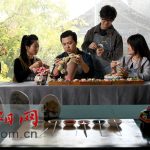
The 2023 Luoyang Archaeological Work Results Report Meeting held on the 20th and 21st revealed that last year, the city carried out a total of 32 archaeological excavation projects, cleaned up a total of 1,361 ancient tombs in various periods, and excavated an area of about 17,000 square meters.
The archaeology of Luoyang shows the important position and role of the Heluo region in the formation of a pluralistic and integrated pattern of Chinese civilization, and also provides empirical evidence for the continuous Chinese civilization for thousands of years.
Population relationships were studied through the ancient DNA of Suyang site
The Suyang site is located in the west of Suyang Village and the south of Xiacun in Zhangwu Town, Yiyang County, Luoyang City, with an area of about 630,000 square meters. Ren Guang, the person in charge of the project, introduced that while doing a good job in field archaeology, the Luoyang Institute of Archaeology cooperated with Northwest University, Peking University, Zhengzhou University and other universities to study the unearthed remains from the perspectives of carbon 14 dating, human bone research, ancient DNA research, plant archaeology, zooarchaeology, environmental archaeology, pottery making methods and origin analysis, and deeply excavated the rich information contained in the site. At present, preliminary progress has been made in various multidisciplinary researches.
According to Ren Guang, judging from the current ancient DNA testing samples, the people at the Suyang site are more closely related to the ancient people in Henan. In addition, the ancient DNA of the Suyang people almost completely overlapped with the population of the Xingyang Wanggou site. Wanggou site is located in the south of Wanggou Village, Xingyang City, and is the largest Yangshao era settlement site among many settlement sites in Xingyang area.
The identification and analysis of animal remains showed that among the domestic animals in the Suyang site, the largest number was domestic pigs, followed by sika deer. Among the domestic pig cultural relics unearthed at the Suyang site, 88.89% of the individuals died between 5 months and 24 months, indicating that the main way for the Suyang people to obtain meat resources at that time was to raise domestic pigs. Plant archaeology found that the agricultural production of the Suyang site was mainly dry farming, and the representative crop was millet. There was also a certain amount of rice in the crops, and the proportion of rice increased during the Longshan culture period.
In the Xuyang cemetery, another carriage and horse pit was found
Xuyang Cemetery, located in the area of Xuyang Village, Minggao Town, Yichuan County, is an active archaeological excavation project excavated by the Luoyang Institute of Archaeology, and is among the “Top Ten New Archaeological Discoveries in China in 2020”. Through exploration, archaeologists have discovered the Lu Hun Rong tomb group more than 2,600 years ago in the Xuyang cemetery, which is the first discovery of the remains of the Rong people in the Central Plains.
According to Wu Yeheng, the person in charge of the project, in 2023, archaeologists will clean up a total of 4 tombs in the Western Zhou Dynasty, 11 tombs in the Eastern Zhou Dynasty, and 3 carriage and horse pits in the Xuyang cemetery. The distribution of tombs in the Western Zhou Dynasty is relatively concentrated, the burial goods have pottery mustaches, or a combination of mustaches and jars, and there are bronze utensils such as copper Ge in individual tombs, and the burial relics are placed outside the head coffin or in the niche above, and the phenomenon of placing shell coins in the feet and mouths of people is more common.
It is worth mentioning that the carriage and horse pit numbered AMK4 has a plane close to parallelogram, with a mouth length of 10 meters, a width of 5.95 meters, and a bottom 2.35 meters deep from the mouth, and 9 cars and 15 horses have been cleared. There are also horses, cows, and sheep’s heads and hooves in the niche in the middle of the south wall of the carriage pit. Wu Yeheng believes that these Eastern Zhou tombs and chariot and horse pits are still relics of the Rong people, and AMK4 reflects different burial characteristics, which helps to deepen the understanding of the diversity of cultural relics in Xuyang cemetery.
Wu Yeheng revealed that in the next step, the work of Xuyang Cemetery will still focus on tomb excavation, mainly exploring the zoning mode and evolution law of the cemetery, in-depth understanding of the cultural connotation of Xuyang Cemetery, and constantly enriching the understanding of the background of the times and the way of ethnic integration.
A group of Han Dynasty tombs was found in the area of the Tangxuan Interchange Hub Project
In the archaeological work carried out in cooperation with the Tangxuan interchange hub project of Qinyi Expressway, the staff of the Municipal Institute of Archaeology discovered the tomb group of the Han Dynasty.
Qinyi Expressway as a whole is in a north-south direction, passing through Shanhua Town and Wushi Town in Yanshi District, and intersecting with Zhengluo Expressway at Tangxuan Interchange Hub. The Tangxuan Interchange Hub is located on the platform south of Baiguwu in Wushi Town.
“281 ancient tombs were actually excavated. Among them, there are 278 tombs in the Han Dynasty, 1 tomb in the Song Dynasty, 1 tomb in the Golden Tomb, and 1 tomb in the Ming and Qing dynasties. He Huifang, the person in charge of the project, said that most of these Han Dynasty tombs were brick tombs and earthen cave tombs. Archaeologists believe that the age of the Han Dynasty tomb group can be divided into four stages: the early Western Han Dynasty, the middle Western Han Dynasty, the late Western Han Dynasty, and the Eastern Han Dynasty, and the age of the tombs gradually changed from north to south.
He Huifang introduced that there are many hollow bricks in the tombs in this area, which are relatively intact, and the number of collected is currently more than 400. The hollow brick is molded as a whole, with ornamentation on the front and side, and the back is mostly plain. Geometric patterns such as persimmon pedicle pattern, rhombic border pattern, wave pattern, and lintoe pattern are mostly seen in ornamentation, as well as image patterns such as animal images and human figures.
Another typical artifact found in the tomb is the pottery 鍍 (móu), which is rare among the artifacts excavated in the Luoyang area. The pottery pot is a small kettle, which is a small cooking utensil used by the ancients, and its function is equivalent to that of a pot. According to archaeologists, it was mainly popular from the early Warring States period to the late Eastern Han Dynasty, and it first came from the Bashu region, which may mean cultural exchanges and integration between different regions.
Archaeologists speculate that the Han Dynasty tomb group of the Tangxuan Interchange Hub of Qinyi Expressway is a civilian burial area that was continuously used in the Han and Han dynasties, which is of great significance for studying the changes of the Han and Han tombs in Luoyang, as well as understanding the residents, cultural exchanges and social background of the area.
Contribute to the archaeology of the Kuva site in Uzbekistan
The reporter learned from the scene of the report meeting that recently, the archaeological survey and exploration of the Kuva site in Uzbekistan participated by the Municipal Institute of Archaeology has been officially launched.
In October 2023, the “Fergana-Luoyang Archaeological Research Center” was established at Fergana University in Uzbekistan. Archaeologists from Luoyang and the university conducted a joint archaeological work at the Kuwa site.
According to Liu Bin, the person in charge of the relevant project, the Ferghana Basin is located in the eastern part of Uzbekistan in Central Asia, and the Kuva site is located in the southern part of the Ferghana Basin. Ferghana, the “Dawan” in China’s ancient historical documents, is an important link on the Silk Road and a place where diverse cultures collide.
According to the plan, in 2024, the joint archaeological work will carry out archaeological exploration of the northern end of the western wall of the ancient city of Kuwa and the inner city wall of the palace area in the northwest corner. In the future, Luoyang Archaeology will further expand the scope of cooperation with the Ukrainian side, and continue to contribute wisdom and strength to heritage protection, cultural inheritance and civilization exchanges in a broader field.
A total of 16 projects introduced the latest achievements at the briefing meeting
●Luanchuan Longquan Cave Ruins
● Yiyang Suyang site
●Erlitou ruins
●The ruins of the ancient city village of Yanshi
●Yanshi Mall Ruins
● Xuyang cemetery
● Han and Wei Luoyang City Palace
●Baicaopo Eastern Han Dynasty cemetery site
●Archaeological work of Qinyi Expressway Tangxuan Interchange Hub Project
● Mengjin sent Zhuang Wei and Jin noble cemetery
● Sui and Tang Dynasty Luoyang City Miyagi axis north of the ruins
● Sui and Tang Dynasty Luoyang City Zhengpingfang ruins
● Luoyang Longmen Tang Dynasty Xiangshan Temple ruins
● Kuva ruins, Uzbekistan
●Including the protection and repair project of the ontology of the Jiacang No. 160 warehouse site
●”Inheriting the Flame of Civilization and Continuing the Chinese Cultural Context” public archaeological work
(Luoyang Daily Financial Media Luoyang Net Reporter Wisdom Correspondent Zhang Bo Feng Jing)








